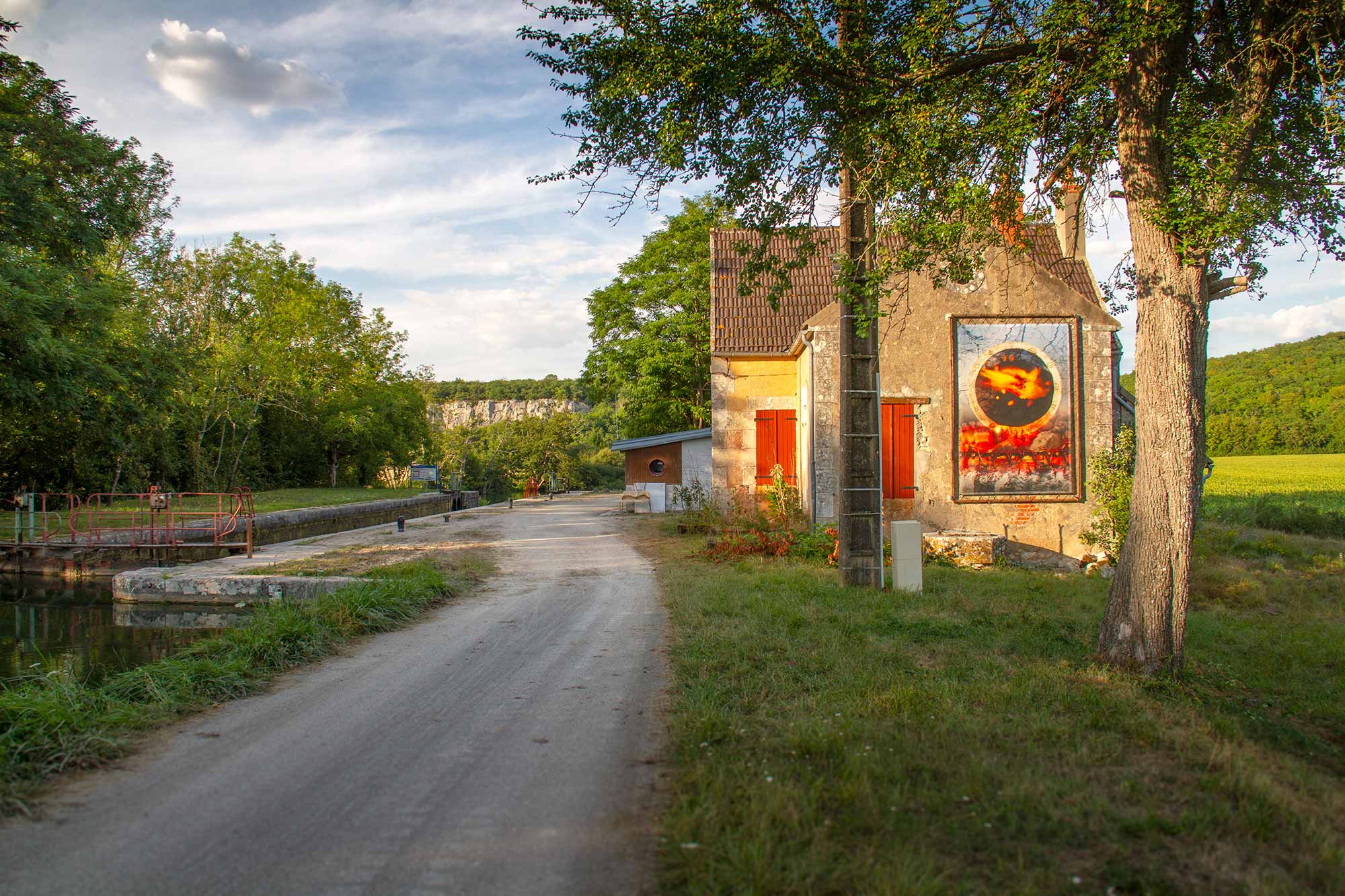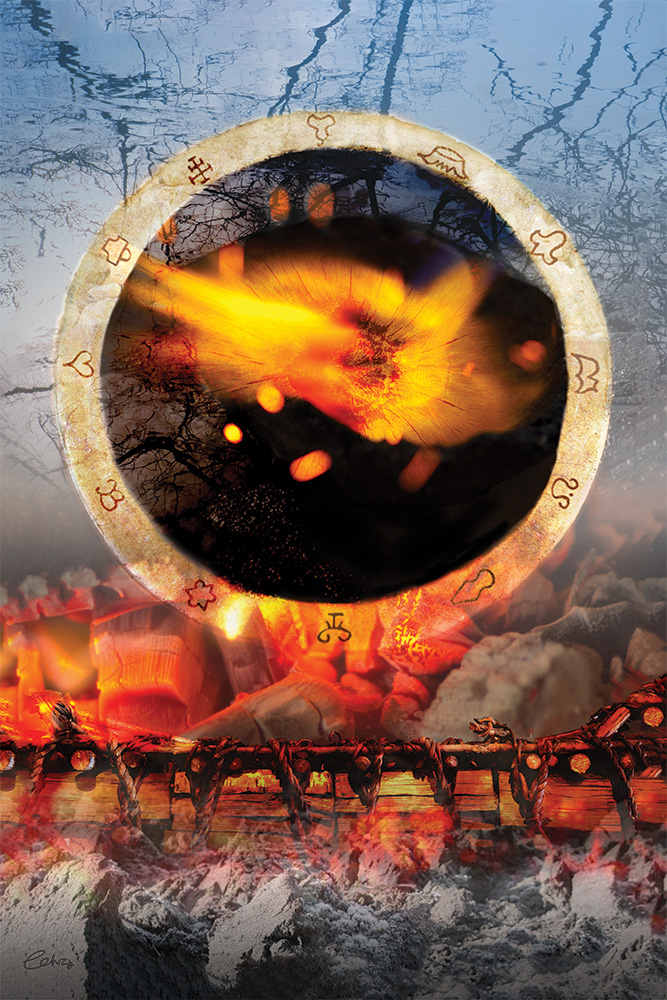Le bois et le feu

Français
Le bois et le feu
Dans le cadre du projet de l'association Maillons-La-Vie « Les temps du flottage» nous avons réalisé un grand collage mural sur la maison de l’écluse située entre Merry-sur-Yonne et Mailly-le-Château. Ce projet est réalisé en collaboration avec les Voies Navigables de France (VNF).
Cette œuvre représente “Le bois et le feu”. L’œuvre évoque les quatre éléments fondamentaux, indispensables au cercle de la vie du bois, et de sa relation à l'Humanité.
La terre d'abord. Solide et fertile, elle constitue l'assise de la santé et du bonheur de l’arbre.
Puis l’eau, essentielle à la croissance de l’arbre. C'est aussi sur l'eau que le bois était "flotté" depuis le Morvan jusqu'à Paris. C'est pour faciliter ce transport périlleux que fût creusé le canal.
Le troisième élément est l’air. Celui qui fait bruisser les feuilles, et que renouvelle la photosynthèse des arbres, nous offrant de l'oxygène jour après jour.
Le dernier élément est le feu, dont le bois des arbres est le combustible. Depuis la préhistoire, le feu apporte aux Hommes chaleur, lumière et protection. Puis une fois le bois transformé en cendres, celles-ci peuvent être mêlées à la terre pour accélérer la pousse de nouveaux arbres.
Le cercle avec la flamme symbolise l’infinité de ce cycle. Les symboles sur le pourtour — marques des anciens ouvriers forestiers — sont un hommage aux bûcherons qui sont au cœur de ce processus.
English
Wood and fire
We have created a large mural collage on the lock-house located along the Canal du Nivernais between Merry-sur-Yonne and Mailly-le-Chateau in Burgundy.
This work is part of the project “Les temps du flottage", initiated by the association Maillons-la-Vie and carried out in collaboration with the Voies Navigables de France (VNF). In this project several artists were asked to give their artistic vision around the theme of “Flottage”, the ancient way to transport firewood to Paris.
The artwork represents “the wood and fire”. It depicts the four fundamental elements, essential to the circle of life of the wood, and its relationship to Humanity.
First, there is earth. Strong and fertile, it forms the basis of the tree's health and happiness.
Then water, vital for the growth of the tree. It was also on the water that the wood was "floated" from the Morvan to Paris. Therefore it was called “Flottage”. It was to facilitate this perilous transport that the canal was dug.
The third element is air. The one that makes the leaves rustle, and that by photosynthesis of the trees, provides us with oxygen day after day.
The last element is fire, for which the wood of the trees is the fuel. Since prehistoric times, fire has brought Humanity heat, light and protection. Once the wood has transformed into ash, it fertilise the soil to accelerate the growth of new trees.
The circle with the flame symbolises the infinity of this cycle. The symbols around the rim - signatures of the forest workers - are a tribute to the loggers who are at central to this process.
Nederlands
Le bois et le feu
In opdracht van de Association Maillon-la-Vie hebben we een kunstwerk in situ gecreëerd op een van de sluishuizen langs het Canal du Nivernais in Bourgogne.
Het werk maakt deel uit van het project “Les temps du flottage” wat Maillons-la-Vie uitvoert in samenwerking met de Voies Navigables de France (VNF). Voor dit project zijn meerdere kunstenaars gevraagd hun artistieke visie te geven op het thema “Flottage”, de oude manier om hout al drijvend te vervoeren vanuit de Morvan naar Parijs.
Het thema van ons werk is Le feu et le bois. Het is gebaseerd op de vier oerelementen die onontbeerlijk zijn voor het hout.
Allereerst is daar de aarde. Solide, sterk en vruchtbaar vormt het de basis voor de gezondheid en het geluk van de boom.
Dan het water, onontbeerlijk voor de groei van de boom. Daarbij was water een belangrijk hulpmiddel om het hout bij de mensen in Parijs te krijgen.
Het derde element is lucht. Het laat de bladeren ruisen en op basis van fotosynthese produceren de bomen de broodnodige lucht (zuurstof) voor de mens.
Tot slot het vuur. Het hout van de boom dient als brandstof. Sinds de prehistorie geeft het vuur warmte, licht en bescherming aan de mensheid. In dit proces wordt het hout getransformeerd tot as, wat weer gebruikt wordt als bemesting voor de grond waarop weer nieuwe bomen kunnen groeien.
De cirkel met de vlam symboliseert de oneindigheid van deze cyclus. De symbolen in de rand van de cirkel, de handtekeningen van de arbeiders, zijn een hommage aan de houthakkers die centraal staan in dit proces.


